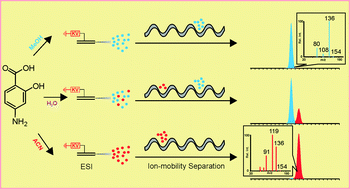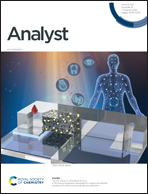LC-MS analysis of p-aminosalicylic acid under electrospray ionization conditions manifests a profound solvent effect†
Abstract
Selected-ion recording (SIR) or multiple-reaction monitoring (MRM) protocols are widely employed for the quantification of targeted analytes by liquid chromatography-mass spectrometry (LC-MS). After chromatographic separation, analytes are desolvated and converted to gaseous ions usually by electrospray-ionization. The chromatographic peaks generated in this way are then integrated for quantification. It is generally assumed that the chromatographic peak intensities are dependent only on the selected MRM-transition protocols and the instrumental parameters set on the mass spectrometer. Using p-aminosalicylic acid (PAS) as a model compound, we demonstrate that the nature of the LC mobile phase exerts a significant effect on the chromatographic peak intensities. Under identical mass spectrometric conditions, chromatographic peak intensities recorded with methanol as the mobile phase were drastically different from those acquired using acetonitrile as the eluent. In fact, the product-ion mass spectra recorded with protonated PAS under different solvent conditions were qualitatively different. The observed differences were attributed to the existence of different protomers of PAS in the gas phase in dissimilar ratios under different solvent-spray conditions. Results from ion-mobility mass spectrometry experiments confirmed this hypothesis. For example, when PAS was sprayed from an acetonitrile solution, the arrival-time profile recorded from the mass-selected m/z 154 ion for protonated PAS showed essentially one arrival-time peak for the N-protonated tautomer. In contrast, the profile recorded from a methanolic PAS solution showed a different arrival-time peak for a more mobile protomer, which was recognized as the carbonyl-protonated PAS. The coexistence of protomers in different and variable ratios in an ensemble of ions generated by electrospray ionization of a single pure compound wields strong ramifications on the identification and quantification of analytes by LC-MS. However, the inclusion of an ion-mobility separator before the mass-selected ions are fragmented and detected by mass spectrometry ameliorates the complications rendered by the coexistence of different protomers and deprotomers.



 Please wait while we load your content...
Please wait while we load your content...